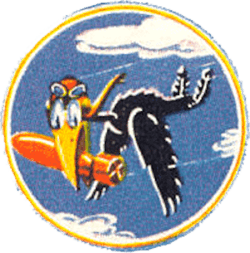670th Bombardment Squadron
| 670th Bombardment Squadron | |
|---|---|
|
Emblem of the 670th Bombardment Squadron | |
| Active | 1943-1945 |
| Country | United States |
| Branch | United States Air Force |
| Type | Bombardment |
The 670th Bombardment Squadron is an inactive United States Air Force unit. It was last assigned to the 416th Bombardment Group. It was last stationed at Camp Patrick Henry, Virginia, and was inactivated on 12 October 1945.
History
Established in early 1943 as a B-25 Mitchell medium bomber Operational Training Squadron under Third Air Force. Received A-20 Havoc light attack bombers and trained in attack and light bombardment tactics; deployed to European Theater of Operations (ETO) in early 1944, assigned to Ninth Air Force in England.
From England, engaged in tactical bombardment of enemy targets mainly in coastal areas of France and the Low Countries. Attacked V-weapon sites in France. Flew a number of missions against airfields and coastal defenses to help prepare for the invasion of Normandy. Supported the invasion in June 1944 by striking road junctions, marshalling yards, bridges, and railway overpasses. Assisted ground forces at Caen and St Lo in Jul and at Brest later in the summer, by hitting transportation facilities, supply dumps, radar installations, and other targets. In spite of intense resistance, the group bombed bridges, railways, rolling stock, and a radar station to disrupt the enemy's retreat through the Falaise gap, 6–9 August 1944. Assisted the airborne attack on the Netherlands in September. Supported the assault on the Siegfried Line by pounding transportation, warehouses, supply dumps, and defended villages in Germany.
Converted to A-26 Invader aircraft in November 1944. Attacked transportation facilities, strong points, communications centers, and troop concentrations during the Battle of the Bulge, December 1944-January 1945. Aided the Allied thrust into Germany by continuing its strikes against transportation, communications, airfields, storage depots, and other objectives, February—May 1945. Bombed flak positions in support of the airborne assault across the Rhine in March 1945. Demobilized in France after the German Capitulation during the summer of 1945; squadron inactivated as a paper unit in November.
Lineage
- Constituted 670th Bombardment Squadron (Light) on 25 Jan 1943
- Activated on 5 Feb 1943
- Inactivated on 11 Oct 1945
Assignments
- 416th Bombardment Group, 5 Feb 1943-11 Oct 1945
Stations
- Will Rogers Field, Oklahoma, 5 Feb 1943
- Lake Charles Army Air Field, Louisiana, 4 Jun 1943
- Laurel Army Airfield, Mississippi, 1 Nov 1943-1 Jan 1944
- RAF Wethersfield (AAF-170), England, 2 Feb 1944
- Melun Airfield (A-55), France, 25 Sep 1944
- Laon/Athies Airfield (A-69), France, 10 Feb 1945
- Cormeilles en Vexin Airfield (A-59), France, c. 25 May 1945
- Laon/Athies Airfield (A-69), France, 27 Jul-13 Sep 1945
- Camp Myles Standish, Massachusetts, 10-11 Oct 1945
Aircraft
- B-25 Mitchell, 1943
- A-20 Havoc, 1943-1944
- A-26 Invader, 1944-1945
References
![]() This article incorporates public domain material from the Air Force Historical Research Agency website http://www.afhra.af.mil/.
This article incorporates public domain material from the Air Force Historical Research Agency website http://www.afhra.af.mil/.
- Maurer, Maurer, ed. (1982) [1969]. Combat Squadrons of the Air Force, World War II (PDF) (reprint ed.). Washington, DC: Office of Air Force History. ISBN 0-405-12194-6. LCCN 70605402. OCLC 72556.
